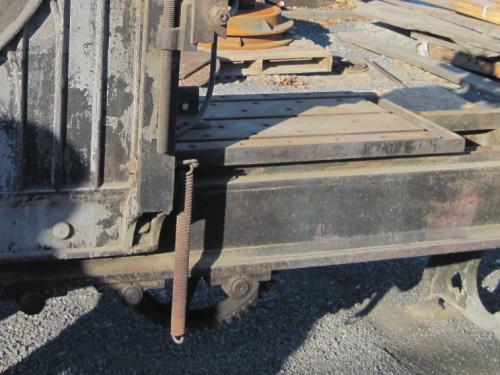Posts: 537
Threads: 15
Joined: Jun 2012
Location: Cambridge, England
Hello All,
As I understand that last statement, the strange marks were on the end of the piece that was at the start of the cutting stroke, if so, the marks could indicate a number of things, I would look for clearance in the clapper mechanism, or maybe the cross rail slide, as the cut is evening out once the cut reaches "Equilibrium" that is after the forces of tool entry settle out and the associated vibration is damped the finish is actually pretty good, another factor that can cause this is too thick an oil film, which settles out after some cutting force is applied too thick a film isn't as a result of too much oil but rather too viscous an oil, thick oil can create a very thick oil films on slides with large bearing surfaces which will be pushed out of the way under loads.
Simply changing the tool angles and nose radius can work wonders in this area.
Best Regards
Rick
Whatever it is, do it today, Tomorrow may not be an option and regret outlasts fatigue.
Posts: 716
Threads: 32
Joined: Apr 2012
Location: Washington, USA
The 1" sq tool is a bit wide. There's a visible shudder on the return stroke - just the table, the bed is steady. A glass of water on the table might tell a story. That push-pause-push strangeness reminds me of stiction but the table moves along pretty quickly (and seems to be worse on the faster return stroke), I don't think it's that. It could be just a harmless anomaly and might not be causing the problem, just might be the tool. I'll try a smaller one and see.
Now for the entertainment. While making test cuts (full 5' strokes), one of the table stops worked loose and the table went off the rack. Pushed it back on and secured the stop. A little later, the linkage to the belt shifter came loose and the table went off the rack again. Reset that, finished the last pass and noticed the overhead pulley gear was coming apart at the bearings.. 
Posts: 2,685
Threads: 29
Joined: Feb 2012
Location: Nova Scotia, Canada
Sunset, it's old, maybe older than I and I have started "coming apart at the bearings" 
Busy Bee 12-36 lathe, Busy Bee Mill drill, Busy Bee 4x6 bandsaw, Homemade 9x17 bandsaw, Ad infinitum.
Posts: 716
Threads: 32
Joined: Apr 2012
Location: Washington, USA
You don't have too many years on me, kid. 
There's a big spring hanging down on the far column. I've often wondered what it was for... Do you suppose it's there to smooth out the table movement? It's just dangling there now.

Posts: 537
Threads: 15
Joined: Jun 2012
Location: Cambridge, England
I reckon I'd try just about every easy thing first, like trying a half dozen tool geometry changes and a few different oil grades etc, before worrying about using a spring to soften the return stroke, after trying all those tools you might just find that the use settles out some of the uneveness,
BTW is it a quick return stroke ? not all of them are and have you set the ways up level as a warped set of ways can chatter in one direction and not the other.
Best regards
Rick
Whatever it is, do it today, Tomorrow may not be an option and regret outlasts fatigue.
Posts: 716
Threads: 32
Joined: Apr 2012
Location: Washington, USA
You're good. Seems one of the shims has worked loose under a foot. And, changing tool geometry has made a world of difference. No chatter marks now! 
Tooling fixed, bearings fixed, belts and gibs tightened.. I'll dabble with the tooling some more as finish has suffered (tearing in 1018). Read somewhere that swinging the tool out 1/4" and sliding a stone under it will true it.
About the table ways, you are spot on. I noticed the left end of the near trough seemed to have a surplus of oil. Bending over to peer at it, I also noticed that the foot was moving a little. Shut the machine off and found I could see oil squishing out when I pressed on the table. Not good. I think I'll jack up that one foot and try another shim under it, rather than going through the leveling process again. Lacking a level, I had removed the table, filled the troughs with water and used a depth mike. The other three feet seem solid and their respective ways are wiping like you'd expect. Something has gone wrong with the stack of scrap that I used for shims.
Another problem occurs at the end of a stoke when the table stop climbs up on top of the dog. The table lifts upward. There has been a repair made, a glob of braze laid down on the dog. It's a bit tall and looks like a file will make short work of things once I have the dog in a vice.
Posts: 537
Threads: 15
Joined: Jun 2012
Location: Cambridge, England
A'Hem, What can I say?
Too many years chasing machinery faults and vibration problems,
The table riding up on stops is not a rare one often seen on old manual surface grinders, and I doo mean "quite old" and some basic Chinese grinders built on a similar design, sorry to those interested as I have no information regarding the name of the design or chinese company where these were built, but I could identify from a picture as I used one quite often about ten years ago.
Best Regards
Rick
Whatever it is, do it today, Tomorrow may not be an option and regret outlasts fatigue.
|








